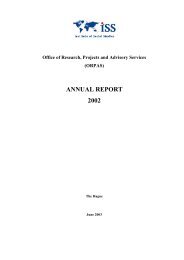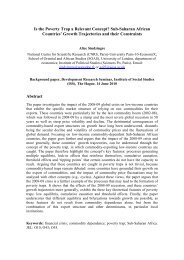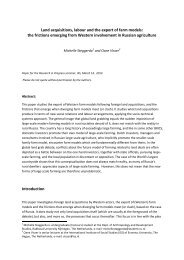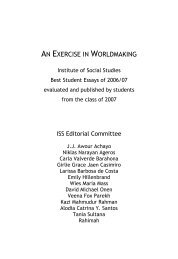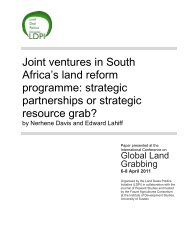AN EXERCISE IN WORLDMAKING 2009 - ISS
AN EXERCISE IN WORLDMAKING 2009 - ISS
AN EXERCISE IN WORLDMAKING 2009 - ISS
Create successful ePaper yourself
Turn your PDF publications into a flip-book with our unique Google optimized e-Paper software.
30 JONATH<strong>AN</strong> CONNOR<br />
cent, which “requires the central government to transfer 15 percent of its<br />
total income to the provinces and cantons” (Keese and Argudo, 2006:<br />
117). It should be noted, however, that Ecuador’s decentralization policies<br />
have not necessarily led to municipal democratization. As John<br />
Cameron (2005: 372) notes, “Decentralization policies in Ecuador, which<br />
were still incipient in the early 2000s, had almost no impact on municipal<br />
democratization. Decentralization legislation lacked any clear requirements<br />
or incentives for municipal governments to operate more transparently<br />
or to foster citizen participation”. Indeed, many Ecuadorian<br />
municipalities continue to be marked by high levels of socioeconomic<br />
inequality, “clientelism” and exclusion (Cameron, 2003: 165). In this context,<br />
the municipality of Guamote stands out as a relatively successful<br />
case of decentralization and municipal democratization. The following<br />
section outlines the region’s transformation in greater detail.<br />
GUAMOTE: L<strong>AN</strong>D REFORM <strong>AN</strong>D PEAS<strong>AN</strong>T-<strong>IN</strong>DIGENOUS ORG<strong>AN</strong>IZATION<br />
Located in the Andean highlands of central Ecuador, Guamote is a predominantly<br />
rural canton with a population of approximately 30,000.<br />
Ninety percent of the municipality’s inhabitants are indigenous Quechua<br />
people spread across small, rural communities. According to official statistics,<br />
Guamote is one of the poorest cantons in Ecuador, with close to<br />
90 percent of its population living in poverty (Bebbington, 2007: 58;<br />
Cameron, 2003: 169). Until the latter half of the twentieth century, the<br />
region was dominated by the traditional hacienda—“large rural estates<br />
characterized by a system of tied Quechua labor… and abusive labor<br />
relationships between owners/managers and the local Quechua population”<br />
(Bebbington, 2007: 58). These local estate owners dominated<br />
Guamote’s social, economic and political scene until the mid-1970s, often<br />
operating “with the acquiescence of municipal officials and local<br />
priests” (Cameron, 2003: 170). Under these circumstances, political and<br />
socioeconomic relations in the region were highly “skewed against the<br />
Quechua population” (Bebbington, 2007: 59).




